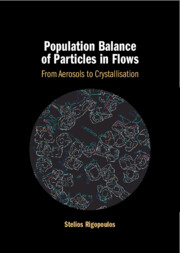Book contents
- Frontmatter
- Dedication
- Contents
- Preface
- Acknowledgements
- Notation
- 1 Introductory Concepts
- 2 Formulation of the Population Balance
- 3 Kinetic and Transport Processes
- 4 Solution of the PBE
- 5 Population Balance in Turbulent Flow
- 6 Case Studies of CFD-PBE Application
- Appendix A Coupling of PBE with Fluid Flow, Heat and Mass Transfer
- Appendix B Implementation of the Conservative Finite Volume Discretisation Method
- Appendix C Derivation of the PDF Transport Equation
- Appendix D Derivation of the Stochastic Field Equation
- References
- Index
1 - Introductory Concepts
Published online by Cambridge University Press: 14 November 2024
- Frontmatter
- Dedication
- Contents
- Preface
- Acknowledgements
- Notation
- 1 Introductory Concepts
- 2 Formulation of the Population Balance
- 3 Kinetic and Transport Processes
- 4 Solution of the PBE
- 5 Population Balance in Turbulent Flow
- 6 Case Studies of CFD-PBE Application
- Appendix A Coupling of PBE with Fluid Flow, Heat and Mass Transfer
- Appendix B Implementation of the Conservative Finite Volume Discretisation Method
- Appendix C Derivation of the PDF Transport Equation
- Appendix D Derivation of the Stochastic Field Equation
- References
- Index
Summary
The population balance is introduced as an approach for modelling problems involving a population of particles with a distribution of one or more properties. Numerous applications are identified. The general methodology of applying the population balance in four basic steps is introduced. Basic concepts such as distributions, choice of distributed variables, kinetic and transport processes and the coupling of the population balance with fluid dynamics, are also introduced.
- Type
- Chapter
- Information
- Population Balance of Particles in FlowsFrom Aerosols to Crystallisation, pp. 1 - 23Publisher: Cambridge University PressPrint publication year: 2024

